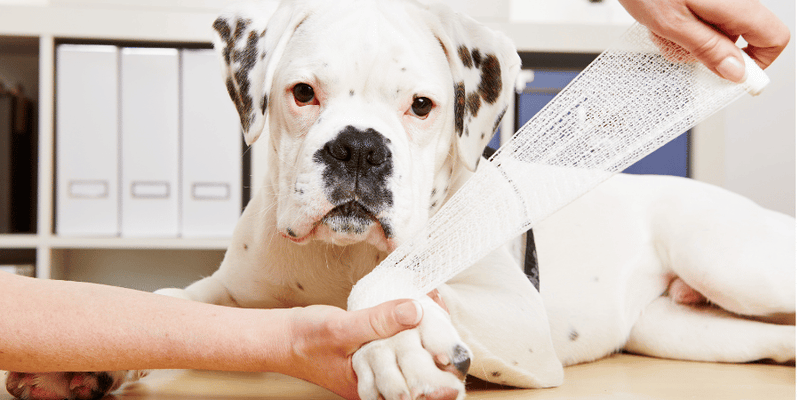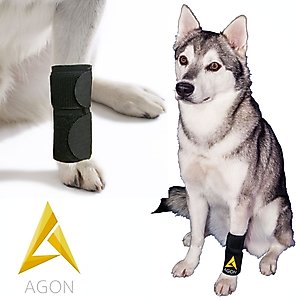Your dog’s paws are tough, but they can still get hurt. When your furry friend steps on something sharp or gets a cut, knowing how to bandage their paw quickly can make all the difference.
You want to help your dog feel better fast and avoid infections. In this guide, you’ll learn simple, step-by-step ways to bandage your dog’s paw safely at home. Keep reading to find out how to protect your pet and give them the care they need right away.
Assessing The Injury
Checking your dog’s paw before bandaging is very important. It helps you know how bad the injury is.
Look closely at the paw to find cuts, swelling, or dirt. This will guide your next steps.
Identifying Common Paw Wounds
Dogs often get small cuts, scrapes, or torn nails on their paws. These injuries can cause pain and bleeding.
Look for signs like redness, bleeding, swelling, or limping. Dirt or debris may be stuck in the wound.
- Small cuts or scrapes
- Broken or torn nails
- Puncture wounds from sharp objects
- Swelling or redness
- Foreign objects stuck in the paw
When To Seek Veterinary Help
Some paw injuries need a vet’s care. Serious wounds can cause infection or last pain.
Contact your vet if the wound is deep, bleeding a lot, or if your dog is limping badly.
- Deep cuts or heavy bleeding
- Swelling that gets worse
- Signs of infection like pus or bad smell
- Your dog refuses to put weight on the paw
- Broken or torn nails that bleed a lot

Credit: bullystickscentral.com
Gathering Supplies
Before bandaging your dog’s paw, gather all needed supplies. This helps you work quickly and carefully.
Having everything ready makes the process smoother and less stressful for your dog.
Essential Bandaging Materials
Start with basic materials that protect and cover your dog’s paw. These items keep the wound clean and safe.
- Sterile gauze pads to cover the injury
- Non-stick pads to prevent sticking to wounds
- Adhesive tape to hold the bandage in place
- Rolled gauze or vet wrap for secure wrapping
- Scissors to cut bandage materials
- Antiseptic wipes or solution to clean the paw
Optional Items For Comfort
These extra items help keep your dog calm and comfortable during bandaging and healing.
- Soft padding to add comfort under the bandage
- Elizabethan collar to stop licking or chewing
- Disposable gloves to keep your hands clean
- Cold pack to reduce swelling before bandaging
- Towel to clean and dry the paw before applying bandage
Step-by-step Bandaging Process
Bandaging a dog’s paw helps protect injuries and speeds healing. It keeps dirt and bacteria away from wounds.
Follow these clear steps to bandage your dog’s paw safely and comfortably.
Cleaning The Paw
Start by gently cleaning the injured paw. Remove dirt and debris to avoid infection.
Use warm water and mild soap or a pet-safe antiseptic solution. Rinse well and pat dry with a clean towel.
Applying The Dressing
Place a sterile non-stick pad over the wound. This stops the bandage from sticking to the injury.
Make sure the dressing fully covers the wound area. You can trim the pad if needed for a good fit.
Wrapping The Paw Securely
Use a soft gauze roll to wrap around the paw. Start at the toes and move up to the leg.
Wrap firmly but not too tight. Check that the bandage does not cut off circulation.
- Wrap evenly without gaps or wrinkles
- Cover the dressing completely
- Secure the end with medical tape or self-adhesive wrap
- Check the bandage daily for looseness or dirt

Credit: www.chewy.com
Aftercare And Monitoring
Taking care of your dog’s paw after bandaging is very important. It helps the paw heal faster and stops problems.
Watch the bandage and your dog closely. This way, you can fix any issues early on.
Keeping The Bandage Dry And Clean
Wet or dirty bandages can cause infections. Always keep the bandage dry and clean to protect your dog’s paw.
If the bandage gets wet, change it quickly. Use a plastic cover or boot to keep it dry during walks.
- Check the bandage daily for dirt or moisture
- Use waterproof covers when outside
- Replace the bandage if it smells bad or looks dirty
Signs Of Infection Or Complications
Watch your dog’s paw for signs of infection or problems. Early detection helps treat issues fast.
Look for redness, swelling, or a bad smell around the bandage area. Your dog may also lick or bite the paw more.
- Red or swollen skin
- Foul odor coming from the bandage
- Excessive licking or biting of the paw
- Discharge or pus around the wound
- Increased pain or limping

Credit: www.amazon.com
Frequently Asked Questions
How Do I Clean A Dog Paw Before Bandaging?
Gently wash with warm water and mild soap. Ensure the paw is completely dry before bandaging.
What Materials Are Best For Dog Paw Bandaging?
Use sterile gauze, self-adhesive bandage, and medical tape. These materials protect and secure the paw effectively.
How Tight Should The Bandage Be On My Dog’s Paw?
The bandage should be snug but not too tight. It should allow normal blood circulation without slipping.
Can I Use Human Bandages On A Dog’s Paw?
Human bandages can work but choose breathable and non-toxic ones. Ensure they fit the dog’s paw well.
How Often Should I Change The Dog’s Paw Bandage?
Change the bandage daily or if it becomes wet or dirty. Regular changes prevent infection.
Conclusion
Bandaging your dog’s paw helps protect wounds and speeds healing. Use clean materials and wrap gently to avoid tightness. Check the bandage often for dirt or slipping. Change it regularly to keep the paw dry and clean. If the paw looks worse or your dog shows pain, see a vet.
Caring for your dog’s paw shows love and keeps them happy. Simple steps can make a big difference in healing. Stay calm and patient during the process. Your dog will thank you with a wagging tail.

